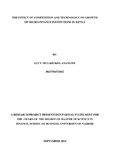| dc.description.abstract | The micro finance industry in Kenya has experienced rapid growth over the years in an
attempt to meet the large demand from the estimated 38 percent of Kenyans lacking access to
financial services. The demand for micro-finance service in Kenya is high yet the industry is
only able to meet about 20 percent of their demand because of lack of financial resources and
the capacity to assess risk process and monitor loans. The specific focus of this study was on
the effects of competition among MFIs on different outcomes as well on the effects of ICT
adoption in the institutional operations. MFIs tend to have a lower outreach when faced with
intense competition. Increased competition is also associated with lower loan repayment,
lower financial performance and lower efficiency. It adopted a descriptive study research
design to collect the required information from the population targeted after which the data
collected was analyzed through quantitative methods to show the causation factor of the
growth in MFIs in Kenya. The target population included the financial institutions which are
members of the Association of the Microfinance Institutions in Kenya. The sample included
34 institutions which have their operations within Nairobi. The sampling procedure applied
was convenience sampling method. Both Primary and Secondary sources of data were used in
the study where Primary data was collected with the use of a questionnaire and the secondary
data collected from the MFI’s annual reports and financial statements. Both descriptive and
inferential methods were used in analysis. Measures of relative position and measures of
relations and associations used were correlation and regression. The significance of the
results was tested by the use of correlation coefficient (R) and the coefficient of
determination (R2) as well as the F-test at 95% significance level. The study findings
included that; both competition and ICT use in MFIs influence their performance thereby
affecting their growth. Competition was found to have negative effects on the organizational
performance while ICT adoption and application in organizational operations was found to
have a positive effect on growth. Thus, the competitiveness of microfinance systems relates
positively to the number of branches (networks) established in the country. Information
technology contributes to the micro financial system in three different ways as follows: ICT
saves the time of the customers and the employees conspicuously, ICT cuts down the
expenses and ICT facilitates the network transactions. Therefore the study recommends that;
to ensure competitiveness of the microfinance sector, policies should be implemented which
shall ensure fair competition to the young micro finance institutions hence facilitating their
growth as well that advanced information system supported by a superior mechanism control
is required to make certain that an information system has achieved the required processes. | en_US |


